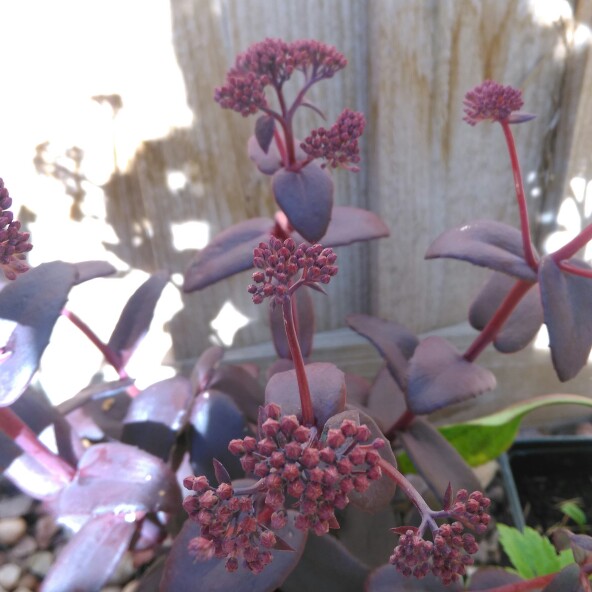
Hylotelephium Telephium sup. Maximum Atropurpureum
Hylotelephium 'Purple Emperor'
http://www.crassulaceae.ch/de/artikel?akID=66&aaID=2&aiID=T&aID=2312 Leaves are particularly dark coloured, common form with whitish flowers Perennial herbs with a rhizome or sometimes thick roots; floral stems from adventitious buds on the rhizome or nodes at the base of the flowering stem of previous years, single, annual or persistent, normally with many leaves with visible internodes, some species possessing sterile shoots. Inflorescences in cymes, composed or paniculate or in umbels-cymes of form, dense, very flowery, terminal but sometimes axillary; flowers in 5 parts (sometimes 4), petals free; flowering in summer or autumn. Until recently, they were included in the Sedum genus. Origin: Europe, Caucasus, Siberia, East Asia, North America. 27 species sometimes divided into subspecies or varieties.
Contributed by @gardentagssucculentexpert
-
Full sun to partial shade
-
Frequent watering
-
A little frost hardy: 32F (0°C)
-
Free draining and fertile
Common name
Hylotelephium 'Purple Emperor'
Latin name
Hylotelephium Telephium sup. Maximum Atropurpureum
type
Succulent
family
Crassulaceae
ph
6.0 - 7.5 Acid - Neutral
Plant & bloom calendar
-
Best time to plant
-
When the plant will bloom
full grown dimensions
 0.45 M
0.50 M
0.45 M
0.50 M
Hylotelephium Telephium sup. Maximum Atropurpureum
http://www.crassulaceae.ch/de/artikel?akID=66&aaID=2&aiID=T&aID=2312 Leaves are particularly dark coloured, common form with whitish flowers Perennial herbs with a rhizome or sometimes thick roots; floral stems from adventitious buds on the rhizome or nodes at the base of the flowering stem of previous years, single, annual or persistent, normally with many leaves with visible internodes, some species possessing sterile shoots. Inflorescences in cymes, composed or paniculate or in umbels-cymes of form, dense, very flowery, terminal but sometimes axillary; flowers in 5 parts (sometimes 4), petals free; flowering in summer or autumn. Until recently, they were included in the Sedum genus. Origin: Europe, Caucasus, Siberia, East Asia, North America. 27 species sometimes divided into subspecies or varieties.
Flowering
From Mid Summer TO Mid Autumn
Most sedum flower through the summer months and into early Autumn
Planting
From Early Spring TO Mid Spring
Plant divisions or seeds in Spring
Propagating by seed
From Early Spring TO Mid Spring
Sow seeds in Spring
Propagating by division
From Mid Spring TO Late Summer
Dividing plants for propagation can be done at any time during the growing season, and divisions will grow readily.
Propagating
From Early Spring TO Late Winter
Hylotelphium will grow roots from stems wherever it comes in contact with soil. Break off a piece, leave it for a day or two to rest and callous over, then stick it in the soil and wait for roots.



























